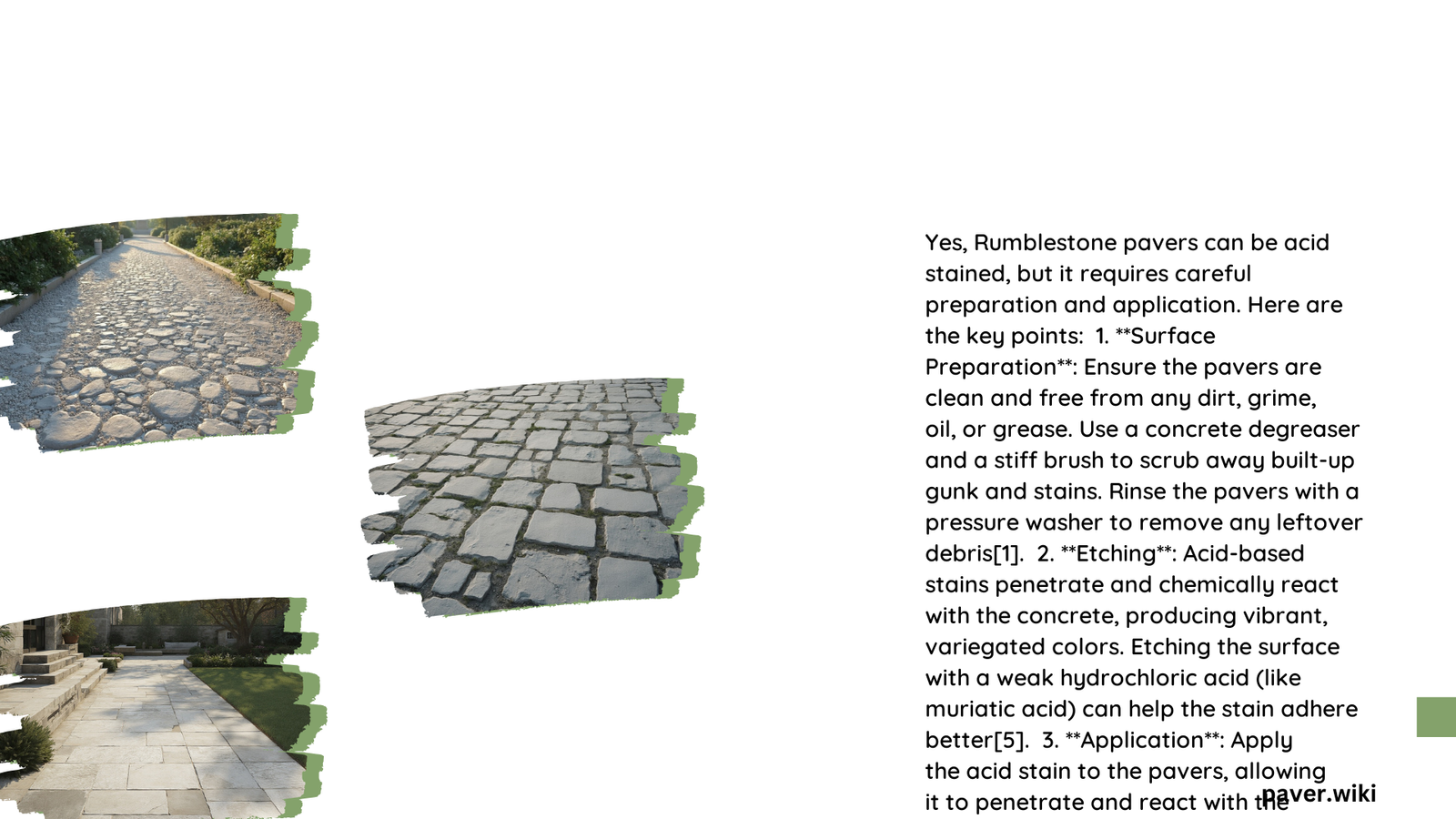Rumblestone pavers, made from concrete, can indeed be acid stained. This process involves applying acidic solutions to the paver surface, which react with the concrete to create unique, long-lasting colors. The success of acid staining depends on factors like the paver’s composition, surface texture, and proper application techniques. While acid staining can enhance the appearance of Rumblestone pavers, it requires careful preparation, application, and maintenance to achieve the desired results.
What Are Rumblestone Pavers?
Rumblestone pavers are concrete pavers designed to mimic the appearance of natural, weathered stone. They are popular for outdoor landscaping projects due to their durability and aesthetic appeal. These pavers are typically made from a mixture of cement, aggregates, and coloring agents, which are then molded and tumbled to create a rustic, aged look.
Can Acid Staining Be Applied to Rumblestone Pavers?

Yes, acid staining can be applied to Rumblestone pavers. The process works because:
- Rumblestone pavers are made of concrete, which reacts with acid stains.
- The porous nature of concrete allows the stain to penetrate and create lasting color.
- The textured surface of Rumblestone pavers can enhance the variegated effect of acid staining.
However, it’s important to note that the success of acid staining on Rumblestone pavers depends on several factors:
- The specific composition of the pavers
- The condition and cleanliness of the surface
- The type of acid stain used
- The application technique
What Are the Benefits of Acid Staining Rumblestone Pavers?
Acid staining Rumblestone pavers offers several advantages:
- Unique Appearance: Creates one-of-a-kind color variations and patterns
- Durability: Penetrates the concrete for long-lasting color
- Enhanced Texture: Highlights the natural texture of the pavers
- Cost-Effective: Less expensive than replacing pavers for a new look
- Versatility: Can be used to complement various landscape designs
How to Acid Stain Rumblestone Pavers?
The process of acid staining Rumblestone pavers involves several steps:
- Surface Preparation
- Clean the pavers thoroughly
- Remove any sealers or coatings
-
Repair any cracks or damages
-
Acid Stain Application
- Choose an appropriate acid stain color
- Apply the stain evenly using a sprayer or brush
-
Allow the stain to react for the recommended time
-
Neutralization
- Apply a neutralizing solution to stop the acid reaction
-
Rinse the surface thoroughly with clean water
-
Sealing
- Apply a concrete sealer to protect the stained surface
- Choose a sealer compatible with acid-stained surfaces
What Safety Precautions Should Be Taken When Acid Staining?
When acid staining Rumblestone pavers, it’s crucial to prioritize safety:
- Wear protective gear (gloves, goggles, and respiratory mask)
- Work in a well-ventilated area
- Keep first aid supplies nearby
- Follow manufacturer’s instructions carefully
- Properly dispose of acid stain residues
What Colors Are Available for Acid Staining Rumblestone Pavers?
Acid stains typically produce earth-tone colors due to their reaction with the minerals in concrete. Common color options include:
| Color Family | Examples |
|---|---|
| Browns | Amber, Coffee, Mahogany |
| Tans | Caramel, Wheat, Sand |
| Greens | Olive, Sage, Forest |
| Blues | Turquoise, Navy, Steel |
| Reds | Terra Cotta, Brick, Burgundy |
The final color will depend on the original color of the Rumblestone pavers and their specific composition.
How Long Does Acid Staining Last on Rumblestone Pavers?
Acid staining is a permanent process that alters the chemical composition of the concrete surface. When properly applied and maintained, the color can last for many years. However, factors that can affect longevity include:
- Exposure to UV rays
- Foot traffic
- Weather conditions
- Maintenance practices
To maximize the lifespan of acid-stained Rumblestone pavers:
- Apply a high-quality sealer
- Reapply sealer every 2-3 years
- Clean the surface regularly
- Avoid harsh chemicals or abrasive cleaning methods
What Are the Potential Challenges of Acid Staining Rumblestone Pavers?
While acid staining can be effective on Rumblestone pavers, there are some potential challenges to consider:
- Unpredictable Results: The final color can vary due to concrete composition
- Limited Color Options: Mostly earth tones are available
- Surface Imperfections: May become more noticeable after staining
- Time-Consuming Process: Requires multiple steps and drying time
- Weather Sensitivity: Outdoor application can be affected by temperature and humidity
Is Professional Help Recommended for Acid Staining Rumblestone Pavers?
While DIY acid staining is possible, professional help is often recommended for several reasons:
- Experience with different paver types and compositions
- Access to professional-grade products and equipment
- Knowledge of proper application techniques
- Ability to handle unexpected issues
- Ensures safety and proper disposal of chemicals
For large areas or complex designs, hiring a professional can lead to better results and peace of mind.
How Does Acid Staining Compare to Other Coloring Methods for Rumblestone Pavers?
Acid staining is one of several methods to color Rumblestone pavers. Here’s how it compares to other options:
| Method | Pros | Cons |
|---|---|---|
| Acid Staining | – Unique, variegated look – Penetrates the surface – Long-lasting |
– Limited color options – Unpredictable results |
| Concrete Dye | – Wide range of colors – Consistent color – Fast application |
– May fade over time – Less natural look |
| Concrete Paint | – Opaque coverage – Many color options – Can hide imperfections |
– May peel or chip – Covers natural texture |
| Integral Color | – Uniform color throughout – Very durable |
– Cannot be changed later – Limited to new installations |
Acid staining offers a unique balance of durability and aesthetic appeal, making it a popular choice for those seeking a natural, variegated look on their Rumblestone pavers.
